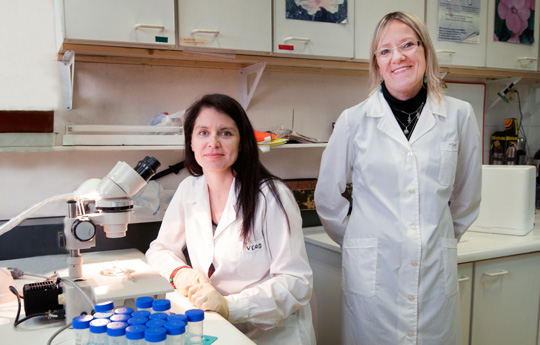Biological and Health Sciences
New experimental models to treat oral cancer
Researchers at the Council use nuclear power to treat tumors.
The ideal therapy to treat cancer is the one that manages to destroy cancer cells without affecting healthy tissue. Boron Neutron Capture Therapy (BNCT) is an alternative radiotherapy technique that has more advantages than the traditional ones. This was proved in different countries where scientists carried out clinical trials for the treatment of glioblastoma multiforme and melanoma, and more recently in head and neck tumors, and liver metastases.
In order to determine the efficiency and toxicity of this treatment, Verónica Trivilin, associate researcher of the CONICET at the National Atomic Energy Commission (CNEA) together with Amanda Schwint, independent researcher of the same institution and her team, conducted different experiments including the hamster cheek pouch model for cancer model.
Regarding the method, the researchers explain that the method is based on the administration of a drug bound to boron-10, which is a boron stable isotope. This method allows to concentrate the boron to the tumour, in order to irradiate it with a beam of low-energy neutrons. Thus, the boron captures the neuron easily and becomes a boron-11 unstable isotope, which decays into an alpha and a lithium 7 particles, which are two heavy particles of high linear energy transfer that cause considerable damage in a short and localized range.
“These particles deposit all their energy in a short distance, that is to say within the area to be treated, and their biological effectiveness is higher than the one of the low LET-radiation such as X or γ rays. The healthy tissue-where the concentration of the boron drug is very low- receives a very small dose because the low-energy neutrons interact very little with the tissue per se”, Schwint explains.
In the recent study published in Proceedings of the National Academy of Sciences of the United States of America (PNAS), the group coordinated by Schint and Trivillin used a liposome as a boron carrier. The liposome is a small vesicle made of the same material as cell membrane. “There are liposomes that have markers that attach to some receptors, which are overexpressed in tumor cells. Therefore they are good to transport substances towards the tumor”, Trivillin says. Nevertheless, in the case of this study, researchers used naked boron liposomes which were selectively incorporated into a tumor due to the characteristics of the tumoral blood vessels.
At the CNEA scientists work on the “peaceful” uses of power energy, so the research team has a nuclear reactor to conduct in vivo experimental studies in animal models. In this case, the therapy is vital because it has more possibilities to succeed where others – such as focused gamma-rays – do not. Schiwint explains that this happens because “there are diffuse cancers, with cells that infiltrate the surrounding normal tissue so the affected volume is not well defined and is hard to fight. Due to the fact that BNCT is based on a biological targeting of cancer cells and it is non-conformational, such as the conventional radiotherapy, it would allow the destruction of tumor lesions keeping the dose on the healthy tissue below the tolerance limit. And, at the same time, can destroy isolated cancer cells infiltrated within normal healthy tissue (micrometastases), which are impossible to detect”.
In this study, the researchers obtained 70 to 80 per cent of efficiency with a low cost in terms of radiotoxicity in the surrounding tissue and with low secondary mucositis. Mucositis is the inflammation of the tissues of the mouth that generally appears when oral cancer is treated with similar techniques.
For the scientists, the objectives of these in vitro experimental studies are to research into different boron compounds, to establish how selective their incorporation of the tumor is, to determine their toxicity and to determine their location within the cell. “If the boron reaches the most sensitive target, which is the DNA, the damage will be more effective”. Furthermore, the group not only studies the effects of the treatment in the tumor, but also its effect in the surrounding tissue, which is very important in the human mucosa due to the fact that often new tumors develop in this tissue, thus impairing the treatment.
“We can treat tumors but as we have the focal points at high risk of malignant transformation, if we do not address the problem in a comprehensive manner, all therapies will fail”, Trivillin concludes.
- By Jimena Naser
- About the research:
- Amanda Schwint. Independent researcher. CNEA.
- Verónica Trivillin. Associate researcher. CNEA.
